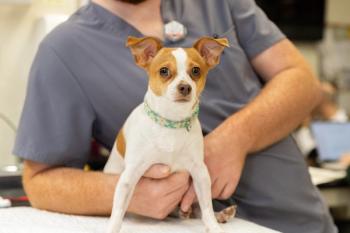
- Vetted November 2020
- Volume 115
- Issue 11
Otitis: the keys to diagnosing this multifactorial inflammatory disease
A look at the causes of and diagnostic best practices for this ubiquitous and often vexing condition.
If it seems as though you’re seeing otitis cases all the time, you probably are. According to Ashley S. bourgeois, Dvm, DACvD, a dermatologist at Animal Dermatology Clinic in Portland, Oregon, and dvm360® editorial Advisory board member, otitis is the second most common reason dogs are brought to a veterinarian.
Although the condition can be chronic or acute, chronic presentations are more common, she said at the inaugural Fetch dvm360® virtual conference. And because chronic or recurrent presentations are typically multifactorial, a thorough history to identify all causal and contributing factors is extremely important. During her session, bourgeois outlined the causes of otitis and discussed the components involved in making the diagnosis.
What causes otitis?
Bourgeois started by breaking down the complexity of causation, particularly for chronic cases. Predisposing factors, primary and secondary causes, and perpetuating factors all play a role in this dynamic. Predisposing factors alone do not cause otitis, but they do increase the risk for the development of infections. Examples of predisposing factors include abnormal ear conformation and topical reactions. When combined with 1 or more primary causes, infection and otitis can occur.
Primary causes of otitis include conditions such as atopic dermatitis, food allergies, and endocrinopathies. If primary causes are not identified and managed, recurrent episodes will likely occur. bourgeois emphasized the significant impact of these primary causes, even in asymptomatic patients. Despite not having clinical evidence of otitis, at least 1 study showed that atopy alone alters the microbiome of the ear. Secondary factors (eg, yeast and bacteria normally present in the ear canal) do not cause pathology in a healthy ear. but in the presence of other primary factors, these secondary factors can lead to overgrowth of microorganisms and infection.
Perpetuating factors (eg, fibrosis, stenosis, calcification) are often irreversible and include changes in anatomy and physiology in response to recurrent otitis. These irreversible factors prevent the resolution of otitis and often are an indication for surgical intervention.
Diagnosis
History and physical exam
The diagnostic approach and historical assessment should include a thorough review of potential primary and secondary factors, as well as predisposing and perpetuating factors. Try to determine whether the problem is acute or chronic and whether there are any inciting factors or other signs of primary disease such as allergies.
During the physical examination, it is important to evaluate the pinnae as well as the ear canals. Note as many details as possible so that you can track these findings on serial exams and monitor for progression or resolution. Note the type and location of inflammation, the presence and appearance of any discharge, and the presence and location of any ulcerations or proliferative tissue. Note the state of the tympanic membrane, and palpate the tissue of the ear canals, noting any fibrosis or calcification.
Otoscopy
A proper otoscopic exam is imperative, bourgeois said, and if the patient is not cooperating, use sedation as needed. For otoscopy, she recommends using a bright light source and at least 10 times magnification. Video otoscopy has many advantages, including the extremely bright light source, the ability to use photos and videos for owner education and documentation, and the ability to manipulate instruments more deeply into the ear canal. The video otoscopy systems allow for constant irrigation (eg, flushing and aspiration), which can be advantageous when performing ear flushes or myringotomies. Additionally, small tears in the tympanum can go unnoticed with hand-held otoscopy, but with video otoscopy, you can see small bubbles emanating from the tear.
Regardless of the type of otoscope used, bourgeois advises using the largest size otoscopy cone possible. A 3-mm cone is the most commonly used size, she said, but the variability in patient size among dogs and cats necessitates having multiple sizes available.
Cytology
Cytology is a mainstay in both diagnosis and monitoring for treatment response. Do not rely on your eyes to diagnose what material is present, bourgeois cautioned, as the true diagnosis can sometimes be surprising. rely on cytology to determine the type of microorganisms and inflammation present. otoscopy can guide you to the most appropriate locations for sampling.
The scoop or rotate technique using a cotton-tipped applicator is an effective way of obtaining samples. For this method, insert the cotton-tipped applicator gently into the canal, but not so far as to contact the tympanum. At the junction of the horizontal and vertical canal, rotate or scoop the applicator, and then roll that material onto a slide. If too many clumps are on the slide, then spread some material onto another slide. repeat this sampling as necessary. bourgeois uses standard Diff-Quik stain, without prior heat fixation, dipping each slide 5 to 8 times in each stain and blotting in between to avoid cross-contamination of stains.
Cytology is simple, inexpensive, and available in the clinic. In this way, it can be an effective monitoring tool and inform clinical decision making. For example, the duration of antibiotics required
to clear an infection varies from patient to patient, so the use of serial cytology can indicate whether an infection is truly resolved and that diagnostic result can help inform whether treatment can be discontinued.
You may also wish to submit a culture and sensitivity, but recent data have shown that the accuracy and inter laboratory agreement of culture and sensitivity data are poor. That said, culture and sensitivity information can be very important when systemic treatment is required, such as for patients with otitis media, where mixed infections occur, where there is suppurative inflammation with little bacteria, or when patients have failed to respond to previous therapy. In chronic cases, you may wish to request an extended sensitivity panel to include polymyxin b or tobramycin. Keep in mind that the presence of biofilm will reduce the ability to culture organisms and reduce the efficacy of treatment.
When a culture is required for otitis media, pass a sterile plastic catheter connected to a sterile syringe filled with 0.5 to 1.0 ml of sterile saline into the middle ear ventral to the malleus. If the tympanic membrane is not yet ruptured, perform a myringotomy at the caudoventral aspect of the tympanum. Inject the saline and aspirate back. Culture the aspirate. Be sure to obtain this sample from the middle ear (not the external canal) for otitis media cases.
Ear flushing
Although flushing is also considered a treatment, Bourgeois emphasizes that it is very important diagnostically to clean and flush the ear canal. There may be evidence of primary causes under the debris in the canal. It is essential to flush out any debris thoroughly to assess the ear canal and tympanic membrane accurately. visualization of the ear canal may also be improved by using cerumenolytics and resolving proliferative tissue using corticosteroids. These adjunctive measures are important because medical treatment is more effective when the ear canal is open and clean. Perform the flushing procedure as follows:
- Anesthetize the patient. Not only does this make the procedure more tolerable for the patient, but if there is a tear in the tympanic membrane the patient will require deep aspiration from the bullae, lest irrigation fluid drains from the bullae through the eustachian tube and into the pharynx, causing aspiration. Use sterile water or saline for irrigation.
- Pass infant feeding tubes (red rubber catheters) down the ear canal.
- Flush and aspirate repeatedly until the canal is clear.
Use polypropylene catheters (stiff, rigid catheters) for myringotomies to drain fluid from or infuse medications into the middle ear. Bourgeois recommends cutting the catheter at a bevel and using the sharp point to create the myringotomy. It is important to remember that cats have septum bullae that make accessing the bullae difficult when flushing the middle ear or delivering medication locally. Patients may exhibit transient Horner syndrome after ear flush procedures. This should not be a deterrent for performing these procedures, she said, as untreated otitis cases also may develop Horner syndrome.
Imaging
Where imaging is necessary, computed tomography (CT) is the most informative modality. radiographs are of limited value due to superimposition of structures. CT scans can accurately detect osteomyelitis or fluid in the bullae and also help determine if medical management is likely futile, such as in cases where the ear canals are completely stenotic and bullae are severely affected. For bullae evaluation, magnetic resonance imaging is not often necessary unless there is concern about an underlying neurologic disorder.
Summary
Bourgeois emphasized that otitis is a multifactorial inflammatory disease of the ear canal and pinnae. otitis commonly becomes chronic due to inadequate control of the primary cause or perpetuating factors. Serial cytology is of great value in diagnosing and monitoring otitis. Finally, ear flushing
is important in diagnosing, treating, and evaluating infections and has a role as maintenance therapy in preventing recurrence of otitis.
Dr. Packer is an associate professor of neurology/neurosurgery at Colorado State University College of Veterinary Medicine and Biomedical Sciences in Fort Collins, and is board certified in neurology by the American College of Veterinary Internal Medicine. She is active in clinical and didactic training of veterinary students and residents and has developed a comparative neuro-oncology research program at Colorado State University.
Articles in this issue
about 5 years ago
How to develop a marketing plan for your veterinary practiceabout 5 years ago
Top trends in veterinary practices for 2021about 5 years ago
Veterinary equipment purchases and taxes: What you need to knowabout 5 years ago
Welcoming and caring for senior petsNewsletter
From exam room tips to practice management insights, get trusted veterinary news delivered straight to your inbox—subscribe to dvm360.





